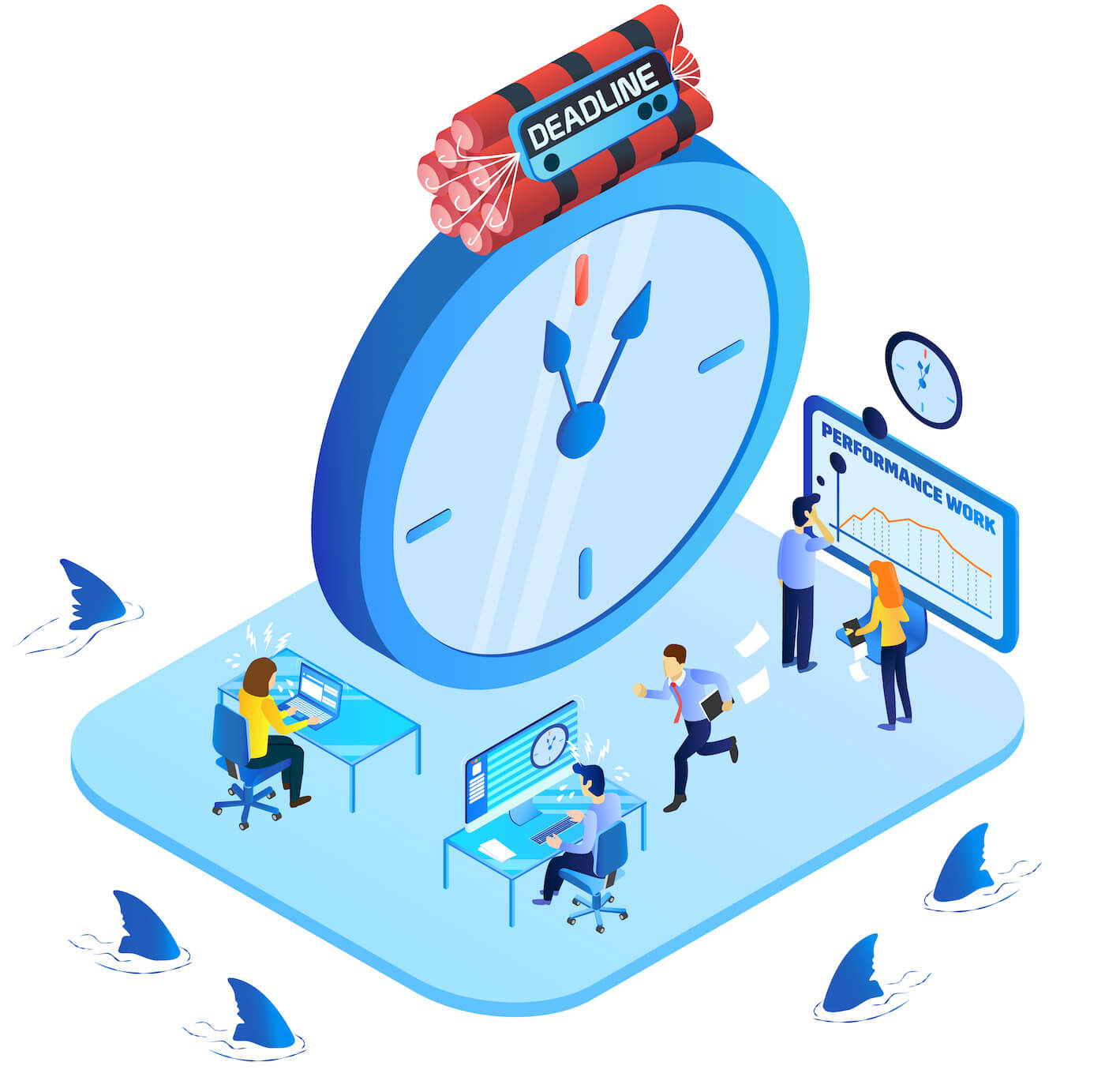How Businesses Can Improve Employee Productivity in 2022
2021 saw major changes to productivity and work levels. And as businesses adapt to COVID-19 protocols and ongoing operational changes in 2022, we are bound to experience new and unprecedented interruptions to regular workflows.
With these challenges, businesses need to be prepared with tips on how to improve productivity in 2022. Read on to learn more:
7 Major Productivity Challenges Business Owners Should Prepare for in 2022

In 2022, we’ll start to see businesses shift back into hybrid settings, still with remote teams. Here are the major productivity challenges upcoming in 2022:
1. Continuing Productivity Lows With WFM and Remote Teams
Leadership has been continually challenged with the ongoing pandemic-inflicted changes. Organizations have had to take extraordinary measures in real-time with no opportunity to plan. Leadership should continue to expect fluctuations with employee availability and business closures/openings.
Expect to remain working with remote teams and other work-from-home scenarios to ease tensions with constantly shifting workplaces. Focus on team productivity during tumultuous periods to keep productivity levels stable.
2. Coordinating With the Hybrid Employee and Flexible Work
Furthermore, leadership will need to accept some workplace flexibility by allowing hybrid employee freedoms. The impact on productivity will be minimal with less micromanaging and more trust. However, careful planning needs to be made so that the hybrid employee understands their situation and crucial productivity demands.
Take input from employees and use time tracking software as a tool for both expectations and goal setting. Look at key indicators like a significant drop in average productivity level and try to correlate this with remote employees’ productivity or the whether or not the employee is engaged with hybrid work.
3. Managing Productivity Throughout Changing Business Trends and Hypercompetition
The COVID-19 pandemic influenced nearly every niche and industry. So while the 2020 economy saw an estimated 200,000 establishments close their doors in the US, businesses are quickly shifting into survival mode and are extremely competitive.
Agility in the changing market will pay off, as well as the capabilities of setting up products, services, or revenue pathways that are available to customers even though they aren’t perfect. This will impact productivity as workers will need to be coached to the agile approach while leadership is potentially adjusting their product for marketing potential.
Employers need to encourage more internal communication to prepare remote workers for these shifts to workload.
4. Managing the Not-Engaged Employee
Employees are spending more time thinking about their work situation. An Agility PR Solutions reported that only 32% of employees had a leader they could trust during the COVID-19 crisis. The pandemic shifts could bring about uncertainty, with more employees questioning whether or not their company is the right fit for them.
There are a number of reasons why employees might not be engaged, but most of it will boil down to your employee experience with your company. This could include hours that they aren’t happy with, colleagues or tasks that they aren’t interested in, or they are continually stressed with the ongoing changes.
It’s vital to have productivity tracking software so that you can measure employee job satisfaction. Hold regular 1:1 meetings with each team member to address work performance or possible reasons for disengagement. Employees should feel more and more connected to the companies’ overall purpose, mission, and values, and they should be able to see the impact through company growth and other goals.
Business owners should consider employee engagement strategies aligned with productivity goals and employee morale.
5. Financial Challenges
The economy is still in a bit of upheaval. Most SMEs can’t confidently say what Q2 or Q3 will look like, let alone their next month’s revenue. Financial challenges impact the bottom line of the business and also productivity.
Poor productivity costs your company money. Employee turnover also impacts productivity levels and your company’s bottom line.
If you have to let a worker go, then your employees and contractors have to make shifts to make this work. This impacts the productivity of the work those workers have to get done; you’ll notice decreases and shifts in productivity levels as adjustments are still settling. Stay available during these shifts.
6. Challenges With Technologies
More and more businesses are moving towards the digital transformation strategy, which involves increasing digitalization for survival and consumer trends. Lockdowns forced virtual products and services, so many businesses that may not be well-equipped to manage this technology will find challenges here. Technology updates and breaking can otherwise wreak havoc on operational efficiency and be seen as a major challenge.
Come up with a digital transformation strategy so that your business continues to have a strong virtual presence. Use digital marketing automation tools to work smarter, not harder. Early planning and expectations sessions will help your team understand expectations with this technology.
7. Developing and Retaining Talent
The US Bureau of Labor Statistics reported that over 4 million Americans left their jobs in September 2021 (alone!). Some are calling what we saw in 2021 the “Great Resignation.”
Regardless, employee turnover is high where productivity challenges are out of balance. If your employees are feeling overworked, underappreciated, and underpaid, they will leave.
Keep in mind a key development and employee retention strategy for high-quality recruits. This involves understanding the root cause of why people are leaving your organization and improving company culture. Seek regular employee feedback and consider implementing a strategic task for focusing on work-life balance.
Tips for Navigating These Challenges

No matter how these challenges are presented, you want to feel well-equipped to handle them. These include making workloads more efficient, preparing for digital team management, employee wellness, and education, and regular check-ins.
Here’s what’s on the agenda for 2022:
- Focus less on workload efficiency. Workload efficiency or not, you sometimes need to be okay with whatever productivity levels you have. When you assess your current productivity load, then you can adjust your finances to represent a better reality. It is simply not the time that you can ask for more from your employees. Let this level of productivity plateau through into Q2 and then start to make adjustments and improvements by Q3. Your workers are tired and need to know that what they are doing (which is likely their best effort) is okay for now.
- Continue to implement digital team management software. Software is going to be your best bet when it comes to managing remote workers. Employee productivity tracking software can support integrations in a number of ways, allow for more open flows of communication, and connect with video chats. Keep the software simple, but you will need to rely on some type of productivity management software and a time tracking system as well.
- Keep casual Fridays. One great way to boost morale is to encourage a casual Friday scenario. Maybe your office is always casual Friday, or maybe your team works 7 days a week. No matter what, try to pick a day where most people are happier (in Western society, this is Friday) and give your employees some more freedom. You may be surprised when you see that your employees are more engaged and ready for the workday.
- Make data your best friend. Right now, there are a lot of ups and downs, but what is consistent is that you can rely on data for managing your operations. Use data consistently (even if it’s not pretty) for goal setting, for regular check-ins and so that your employees stay familiar with your process. Time tracking software can provide data on employee activity, employee performance, and significant productivity impacts.
How to use Time Tracking Software for Employee Productivity
It’s clear that business leaders need to reassess their operational strategies for 2022. With productivity being impacted by a number of market-based and external factors, companies need to re-focus on their company culture and employee engagement. Happy employees are far more productive.
In this case, you’ll want to use monitoring software for connecting through these challenges. Whether you are working with remote teams, hybrid employees, or in-house staff, connect using software to make things easier. Time tracking and productivity software can be a good middle-ground to assess data on employee performance and burnout. Leadership also needs to ease up on operational efficiency to address workplace issues. There is no reason to push for efficiency if the workflow is broken. Take Q1 to slow down and then reassess the situation so that it makes sense for your business.
These strategic shifts are especially important in a highly competitive market. You want your talent to remain with your company and remain happy. Source time tracking and productivity tools for increasing productivity and employee satisfaction throughout the ever-changing markets in 2022.
By SoftActivity Team.